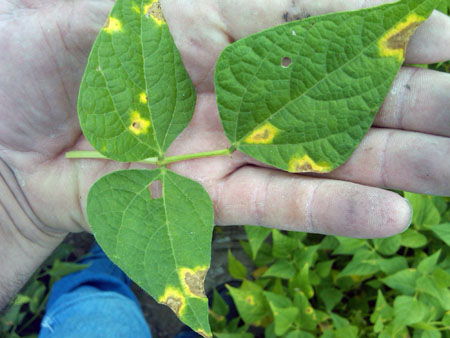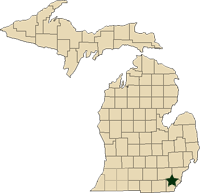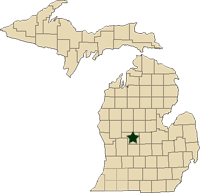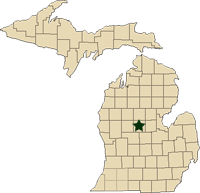Regional reports on Michigan field crops – September 8, 2011
MSU Extension educators’ pest and field crop updates for Michigan.
This week’s regional reports:
- Southeast Michigan – Ned Birkey
- West Central Michigan – Fred Springborn
- Central Michigan – Paul Gross
Southeast Michigan – Ned Birkey, Michigan State University Extension
|
Weather was hot last week, with a high temperature of 98°F on a farm near Detroit Metro Airport last Friday afternoon, September 2, and a high temperature of 94°F last Saturday afternoon near Monroe. Since stormy weather Saturday evening, we have had more than 1 inch of rain and temperatures only in the 60s. No one here is using the “f” word, as frost is not a threat nor is it forecasted. Our normal first killing frost date is around October 10. Degree day comparisons for the past six years indicate that 2011 is above average: 2006 = 2461 GDD; 2007 = 2513 GDD; 2008 = 2289 GDD; 2009 = 1986 GDD; 2011 = 2724 GDD; 2011 = 2501 GDD. The average 50*F for the past five years is 2394.
Alfalfa seeding is now finished with the rain that is projected to continue until perhaps Monday, September 12. Farmers need to allow four to six weeks for establishment prior to a killing frost and the wet soil conditions will prevent further seeding.
Corn maturity ranges from milk to dent stages, with some gray leafspot, northern corn leaf blight and anthracnose leaf diseases. I expect good yields as pollination seems to have occurred after the extreme heat of mid-July. Corn silage harvest was going to get started until the rains came last weekend. Insect traps will be pulled out tomorrow, September 8, even though freezer sweet corn is still in demand.
Soybeans are generally in the R5 to R6 growth stages; some early maturing varieties have leaves that are starting to turn color. Most fields are very green, so yield potential is very good. Grasshoppers are the main insect found. More sudden death syndrome can be found in fields, though is not widespread.
Wheat seeding should start after October 1, though some 2011 prevented-planted cornfields may get seeded early, depending upon the weather and soybean maturity and harvest.
West Central Michigan – Fred Springborn, Michigan State University Extension
|
Weather has ranged from hot to cool this week with highs approaching 90 at the end of last week followed by highs in the low 60s on Labor Day (September 5). Soil moisture is generally adequate for plant growth and development.
Corn ranges from milk stage R3 in the very late planted fields to hard dent R5 in early planted fields. It is always tough to get an accurate estimate of the size of the crop due to normal variability within and between fields, and it is especially challenging this year with a corn crop that was planted over a nearly 45-day time period this spring.
Several fields will surprise producers when they are harvested, the surprises will be pleasant in some cases and disappointing in others. Some of the later planted fields may produce better yields than some of the earlier planted corn due to timing of pollination and it’s also a good time to remember that stalk height is not necessarily an indicator of yield potential. The very late June planted corn appears to have generally good yield potential, but will need some time yet to mature.
Silage harvest is underway. Corn earworms are present in a few fields as are European corn borers. Western bean cutworm larvae are getting harder to find in ears as many have dropped to the soil to begin overwintering.
Dry bean harvest is underway. A few fields have some bacterial blight present. The presence of bacterial blight serves as a reminder of the importance of planting clean seed that is disease-free. There is also some bean leaf rust present at low levels and a minor amount of white mold in some fields.

Bacterial blight on dry bean.
Soybeans are still filling pods in many fields, and just a few fields have started to turn.
Third and fourth cutting alfalfa is in progress on many farms. New seedlings are still going in this week. Many new fall seedlings have emerged nicely.
Central Michigan – Paul Gross, Michigan State University Extension
|
Weather
Rainfall totals across the region over the past two weeks range from half-inch to well over 1 inch in some areas. Growing degree day totals from March 1 are just over 2,400. The consensus among farmers is that we have adequate moisture to finish the crop, but need a long, warm fall. Subsoil moisture is considered short in many areas.
Commodity reports
The corn crop is approaching maturity with some early planted fields expected to reach black layer next week. Later planted fields are in R5, where nearly all kernels are dented. The questions now are will the crop dry down and what will it cost to dry the crop this year? Most agree we will have average yields. Corn silage harvest is well underway across the region. Tonnage is lower than normal in some areas due to moisture and heat stress this summer. There are reports of anthracnose in some areas.
The soybean crop has benefited from the August rains and pods are being set in the top nodes. Early planted beans are beginning to turn. Several farmers have reported they feel we could have above-average yields this year.
Field preparations are being made for wheat planting. Some wheat was aerial seeded last week in soybeans. Farmers are reminded that high yields starts with variety selection, good soil fertility, seedbed preparation and precision planting.
Dry bean harvest is just getting underway. Most are expecting below-average yields. The early spring rains caused root rots and the hot weather caused problems during flowering. Growers are reporting that their later planted fields have the best yield potential.
Harvest of fourth cutting alfalfa is wrapping up for farmers on aggressive cutting schedules. The balance of the harvest will be completed after that first killing frost when the crop goes dormant. New summer seedings have benefited from the recent rains and are looking very good.
The early sugarbeet harvest will begin next week. The August rains have added tonnage to a crop that suffered in the dry weather of July.



 Print
Print Email
Email






